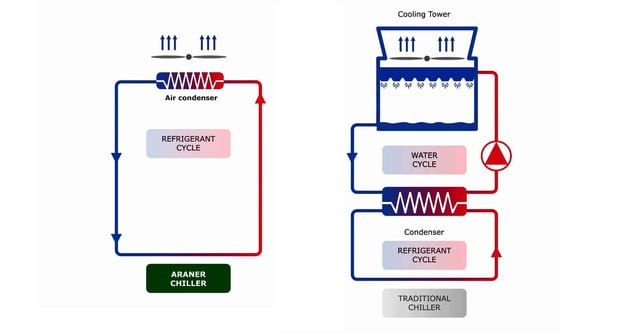Accomplishing a successful district cooling system design has become an essential strategy for future urban development schemes.
Cooling choices have always been considered a key impact in architectural development. However, increasing cooling demand in a context of rising energy prices and climate change sensitivity has shined a renewed light on district cooling design.
Its fundamental premise is simple: cooling is produced at a central source, from which it is distributed. Paired with renewable sources aiming at the energy transition, district cooling has been hailed for both its economic and environmental benefits.
In fact, a report by the UN Environment Program has recommended district energy systems as a best practice to provide a local, affordable and low-carbon energy supply.
In this context, let’s take a look at some crucial aspects of successful district cooling system design.
Efficiency: key in achieving successful district cooling system design
To begin with, district cooling systems are known to be more energy-efficient than individual cooling systems, thanks to the use of centralized cooling plants as well as efficient technologies and equipment, such as high-efficiency chillers and heat exchangers.
In fact, this technology has been credited with offering more than 40% of energy efficiency improvements and 20% lifecycle cost savings compared to conventional air conditioning systems. (Ibrahim Dincer, Azzam Abu-Rayash, 2020).
This efficiency is being pushed further by cutting-edge district cooling plant design including efforts like waste heat recovery, where excess heat generated during the cooling process can be captured and employed for other purposes.
This expanded efficiency is particularly crucial when facing the growth in air conditioning demand. Additionally, diligence in district cooling system design can avoid costly errors as well as outages.
This benefit is added to other environmental advantages that are linked to district cooling design models, including their reduced carbon footprint and the possibility to incorporate renewable energy sources.
Key aspects in district cooling system design
District cooling system design presents three major components that must be addressed to ensure maximum efficiency:
- The central power plant, where all key cooling equipment is located (such as chillers and pumps, among others)
- The distribution piping network
- Energy transfer stations (that is, each building’s interconnections)
Looking through the lens of this basic radiography of a district cooling design, the following are some of the key aspects that are key in pushing these systems’ efficiency to the front
1. Analyze needs of the project
Any successful district cooling system design starts at analyzing the needs of the project.
On the one hand, this involves a thorough analysis of the cooling load requirements of the buildings within the district. Factors such as building size, occupancy patterns, and insulation levels must be considered here.
On the other hand, extensive research must be dedicated to the district cooling plant design, so that it displays the appropriate capacity and redundancy to meet peak cooling demands.
2. Put sustainability at the front
Adequate district cooling system design today incorporates notions around sustainability. As we’ve mentioned above, energy efficiency stands at the heart of this priority. High-efficiency chillers, pumps, and heat exchangers should be considered to minimize energy consumption and reduce carbon emissions.
But there are other key choices, including the integration of renewable energy sources, and waste heat recovery systems.
Combined heat and power initiatives have also been employed in this quest for enhanced sustainability. However, it’s worth mentioning that a comparative guide between combined heat and power and heat pumps suggests industrial heat pumps are able to offer more certainties in certain contexts.
3. Incorporate thermal energy storage
Thermal energy storage (TES) systems are able to optimize cooling plant operations and meet varying demand. These have been instrumental both in incorporating typically intermittent renewable energy sources; as well covering peak demand periods.

4. Adapt to local resources
Yet another key topic is the choice of energy sources for a district cooling system design. As such, innovative schemes have seen the use of deep, cold lake or seawater in areas with cold winters. For areas where water scarcity can represent a challenge, such as district cooling in Saudi Arabia, centrifugal air-cooled chillers have shown great results with zero water consumption.
5. Consider heat exchange specifications
Engineers and developers considering district cooling plant design must also pay close attention to heat exchangers, which guarantee efficient heat transfer between the cooling plant and individual buildings.
Factors such as the heat exchanger type (plate, shell-and-tube, etc.), its materials and sizing, among other factors, can have a significant impact on its performance. For instance, efficient cooling towers have been successfully incorporated as specialized heat exchangers in industrial environments.
6. Ensure adequate piping
Pipe sizing, pressure drop, hydraulic balance, and insulation requirements are all relevant in guaranteeing reliability and efficiency in district cooling systems.
Looking for a method to supercharge your district cooling system design? Look no further. At Araner we design and implement cutting-edge district cooling systems responding to the particular needs of every project. Get in touch with our team and find out how we can help you.










